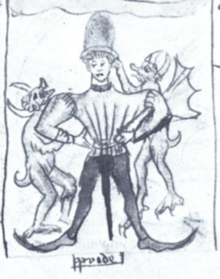
Sir Gowther is a relatively short Middle English tail-rhyme romance in twelve-line stanzas, found in two manuscripts, each dating to the mid- or late-fifteenth century.[1][2] The poem tells a story that has been variously defined as a secular hagiography, a Breton lai and a romance,[3][4] and perhaps "complies to a variety of possibilities."[5] An adaptation of the story of Robert the Devil, the story follows the fortunes of Sir Gowther from birth to death, from his childhood as the son of a fiend, his wicked early life, through contrition and a penance imposed by the Pope involving him in a lowly and humiliating position in society, and to his eventual rise, via divine miracles, as a martial hero and ultimately to virtual canonization. But despite this saintly end, "like many other lays and romances, Sir Gowther derives much of its inspiration from a rich and vastly underappreciated folk tradition."[6]
- ^ Laskaya, Anne and Salisbury, Eve (Eds). 1995. The Middle English Breton Lays. Kalamazoo, Michigan: Medieval Institute Publications.
- ^ Vandelinde, Henry. 1996. Sir Gowther: Saintly knight and knightly saint. Neophilologus, volume 80, number 1/January, 1996.
- ^ Mills, Maldwyn. 1973, Six Middle English Romances. J M Dent and Sons Limited, Everyman’s Library.
- ^ Laskaya, Anne and Salisbury, Eve (Eds). 1995.
- ^ Laskaya, Anne and Salisbury, Eve (Eds). 1995.
- ^ Laskaya, Anne and Salisbury, Eve (Eds). 1995.